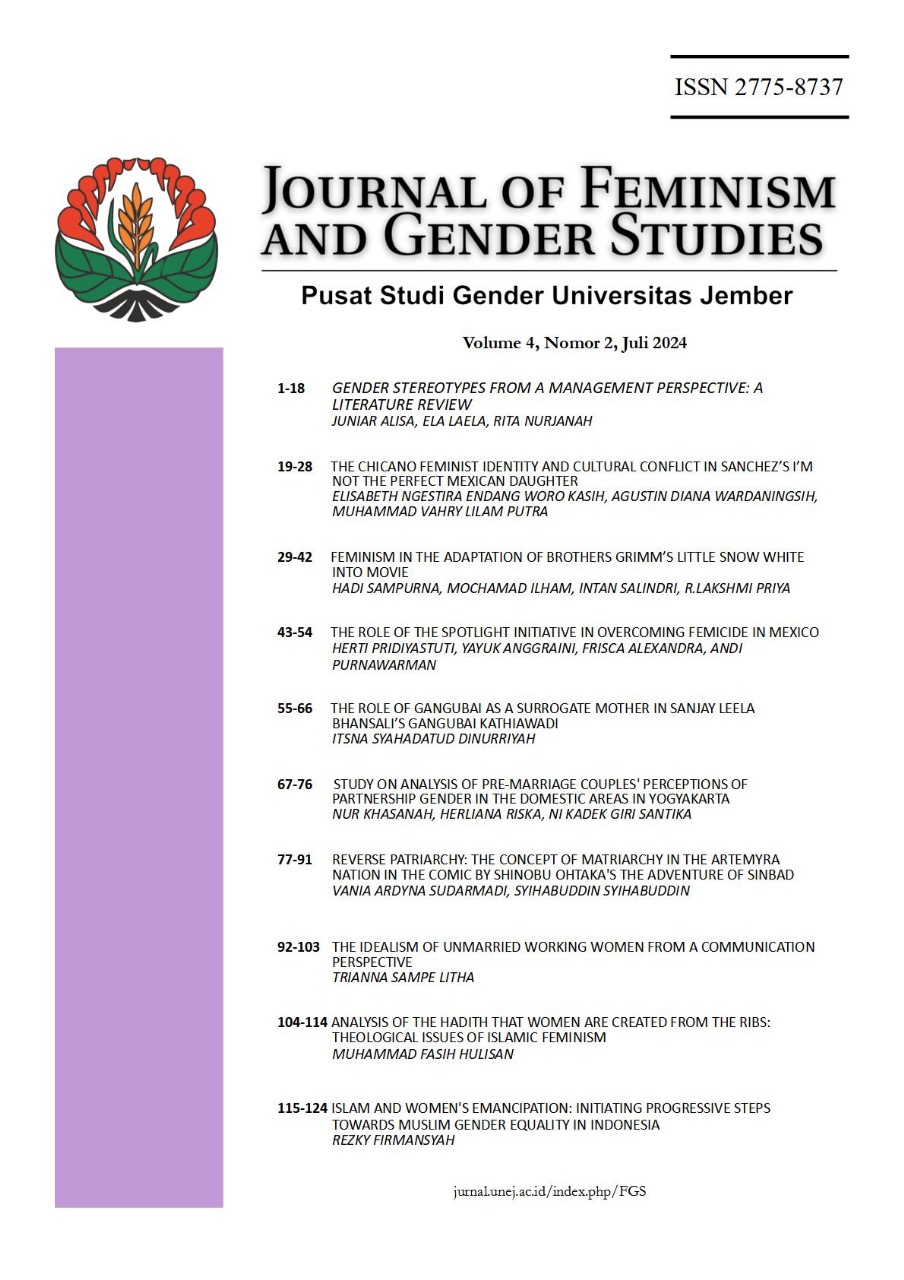Gender Stereotypes from A Management Perspective: A Literature Review
Abstract
Gender stereotypes are often assumed to limit the capacity to develop and make decisions. Gender stereotypes are also considered the main reason for the glass ceiling and maze effect. This study uses a literature review to synthesize gender stereotype research. A literature search was carried out with publication years limited from 2003 to 2023. The literature analyzed was collected from Scopus-indexed journals with the ScienceDirect, Springer, Wiley Online Library, and Emerald Insight databases. This research synthesizes and analyzes 40 relevant articles focusing on discussing gender stereotypes. Based on the analysis results, men and women have different stereotypes. Men are considered superior in their characteristics. However, while gender stereotypes still hamper women, there are reasons to remain optimistic. When women are the targets of gender bias, it is not just them but the organizations where they work and society as a whole who suffer. Conclusions with limitations and recommendations for further research are included in the article.
References
Bielby, D. D., & Bielby, W. T. (1988). She Works Hard for the Money: Household Responsibilities and the Allocation of Work Effort. American Journal of Sociology, 93(5), 1031–1059. https://doi.org/10.1086/228863
Bordalo, P., Coffman, K., Gennaioli, N., & Shleifer, A. (2016). Stereotypes. The Quarterly Journal of Economics, 131(4), 1753–1794. https://doi.org/10.1093/qje/qjw029
Brett, J. M., & Stroh, L. K. (1997). Jumping Ship: Who Benefits From an External Labor Market Career Strategy ? Journal of Applied Psychology, 82(3), 331–341. https://doi.org/10.1037/0021-9010.82.3.331
Burgess, D., & Borgida, E. (1999). Who Women Are, Who Women Should Be: Descriptive and Prescriptive Gender Stereotyping in Sex Discrimination. Psychology, Public Policy, and Law, 5(3), 665–692. https://doi.org/10.1037//1076-8971.5.3.665
Carli, L. L. (2001). Gender and Social Influence. Journal of Social Issues, 57(4), 725–741. https://doi.org/10.1111/0022-4537.00238
Carpini, J. A., Luksyte, A., Parker, S. K., & Collins, C. G. (2023). Can a Familiar Gender Stereotype Create a Not-so-familiar Benefit for Women? Evidence of Gendered Differences in Ascribed Stereotypes and Effects of Team Member Adaptivity on Performance Evaluations. Journal of Organizational Behavior, 44(4), 590–605. https://doi.org/10.1002/job.2702
Chisholm-Burns, M. A., Spivey, C. A., Hagemann, T., & Josephson, M. A. (2017). Women in Leadership and the Bewildering Glass Ceiling. American Journal of Health-System Pharmacy, 74(5), 312–324. https://doi.org/10.2146/ajhp160930
Diekman, A. B., & Eagly, A. H. (2000). Personality and Social Psychology Bulletin SPSP Student Publication Award For 1999 Stereotypes as Dynamic Constructs: Past, Present, and Future. Personality and Social Psychology Bulletin, 26(10), 1171–1188. https://doi.org/10.1177/0146167200262001
Dubbelt, L., Rispens, S., & Demerouti, E. (2016). Gender Discrimination and Job Characteristics. Career Development International, 21(3), 230–245. https://doi.org/10.1108/CDI-10-2015-0136
Eagly, A. . (1987). Sex Differences in Social Behavior (1st ed.). New York: Psychology Press.
Eagly, A. H., & Carli, L. L. (2003). The Female Leadership Advantage: An Evaluation of the Evidence. The Leadership Quarterly, 14, 807–834. https://doi.org/10.1016/j.leaqua.2003.09.004
Eagly, A. H., & Karau, S. J. (2002). Role Congruity Theory of Prejudice Toward Female Leaders. Psychological Review, 109(3), 573–598. https://doi.org/10.1037//0033-295X.109.3.573
Eagly, A. H., Mladinic, A., & Otto, S. (1991). Are Women Evaluated More Favorably Than Men?: An Analysis of Attitudes, Beliefs, and Emotions. Psychology of Women Quarterly, 15, 203–216. https://doi.org/10.1111/j.1471-6402.1991.tb00792.x
Fuegen, K. (2015). The Effects of Gender Stereotypes on Judgments and Decisions in Organizations. Social Psychology of Gender, 79–98. https://doi.org/10.1016/S0882-6145(07)24004-4
Galanaki, E., Papalexandris, N., & Halikias, J. (2009). Revisiting Leadership Styles and Attitudes towards Women as Managers in Greece. Gender in Management: An International Journal, 24(7), 484–504. https://doi.org/10.1108/17542410910991782
Garcıa-Gonzalez, J., Force, P., & Jimenez-Sanchez, M. (2019). Men and Women Differ in Their Perception of Gender Bias in Research Institutions. PLoS ONE, 14(12), 1–21. https://doi.org/10.1371/journal.pone.0225763
Gewinner, I. (2017). Gendered Career Choices and Stereotypes: A Theoretical Approach Irina. Discourses on Gender and Sexual Inequality, 23, 71–89. https://doi.org/10.1108/S1529-212620170000023004
Gill, M. J. (2004). When Information does not Deter Stereotyping: Prescriptive Stereotyping can Foster Bias under Conditions that Deter Descriptive Stereotyping. Journal of Experimental Social Psychology, 40, 619–632. https://doi.org/10.1016/j.jesp.2003.12.001
González, M. J. C., Cortina, C., & Rodríguez, J. (2019). The Role of Gender Stereotypes in Hiring: A Field Experiment. European Sociological Review, 35(2), 187–204. https://doi.org/10.1093/esr/jcy055
Haines, E. L., Deaux, K., & Lofaro, N. (2016). The Times They Are a-Changing . . . or Are They Not ? A Comparison of Gender Stereotypes , 1983 – 2014. Psychology of Women Quarterly, 1–11. https://doi.org/10.1177/0361684316634081
Heilman, M. E. (2001). Description and Prescription : How Gender Stereotypes Prevent Women ’ s Ascent Up the Organizational Ladder. 57(4), 657–674.
Heilman, M. E. (2012). Gender Stereotypes and Workplace Bias. Research in Organizational Behavior, 32, 113–135. https://doi.org/10.1016/j.riob.2012.11.003
Heilman, M. E., & Chen, J. J. (2005). Same Behavior, Different Consequences: Reactions to Men’s and Women’s Altruistic Citizenship Behavior. Journal of Applied Psychology, 90(3), 431–441. https://doi.org/10.1037/0021-9010.90.3.431
Heilman, M. E., & Okimoto, T. G. (2007). Why Are Women Penalized for Success at Male Tasks?: The Implied Communality Deficit. Journal of Applied Psychology, 92(1), 81–92. https://doi.org/10.1037/0021-9010.92.1.81
Heilman, M. E., & Parks-stamm, E. J. (2007). Gender Stereotypes in the Workplace: Obstacles to Women’s Career Progress. Social Psychology of Gender, 47–77. https://doi.org/10.1016/S0882-6145(07)24003-2
Hentschel, T., Heilman, M. E., & Peus, C. V. (2019). The Multiple Dimensions of Gender Stereotypes: A Current Look at Men’s and Women’s Characterizations of Others and Themselves. Frontiers in Psychology, 10(JAN), 1–19. https://doi.org/10.3389/fpsyg.2019.00011
Jonsen, K., Maznevski, M. L., & Schneider, S. C. (2010). Gender Differences in Leadership – Believing is Seeing: Implications for Managing Diversity. Equality, Diversity and Inclusion: An International Journal, 29(6), 549–572. https://doi.org/10.1108/02610151011067504
Jost, J. T., & Kay, A. C. (2005). Exposure to Benevolent Sexism and Complementary Gender Stereotypes : Consequences for Specific and Diffuse Forms of System Justification. Journal of Personality and Social Psychology, 88(3), 498–509. https://doi.org/10.1037/0022-3514.88.3.498
Juodvalkis, J. L., Grefe, B. A., Hogue, M., Svyantek, D. J., & DeLamarter, W. (2003). The Effects of Job Stereotype, Applicant Gender, and Communication Style on Ratings in Screening Interviews. The International Journal of Organizational Analysis, 11(1), 67–84. https://doi.org/10.1108/eb028963
Kaushik, N., Sharma, A., & Kaushik, V. K. (2014). Equality in the Workplace: A Study of Gender Issues in Indian Organisations. Journal of Management Development, 33(2), 90–106. https://doi.org/10.1108/JMD-11-2013-0140
Khairi, A., Giatman, M., Maksum, H., Jalinus, N., & Abdulah, R. (2023). Menepis Stereotipe Gender Kepemimpinan Perempuan di Fakultas Keguruam dan Ilmu Pendidikan. Al Qalam: Jurnal Ilmiah Keagamaan Dan Kemasyarakatan, 16(6), 2451. https://doi.org/10.35931/aq.v16i6.1689
Koburtay, T., Syed, J., & Haloub, R. (2019). Congruity between the Female Gender Role and the Leader Role: A Literature Review. European Business Review, 31(6), 831–848. https://doi.org/10.1108/EBR-05-2018-0095
Koenig, A. M., & Eagly, A. H. (2014). Extending Role Congruity Theory of Prejudice to Men and Women With Sex-Typed Mental Illnesses. Basic and Applied Social Psychology, 36(1), 70–82. https://doi.org/10.1080/01973533.2013.856789
Krishna, A., & Orhun, A. Y. (2022). Gender (Still) Matters in Business School. Journal of Marketing Research, 59(1), 191–210. https://doi.org/10.1177/0022243720972368
Kusterer, H. L., Lindholm, T., & Montgomery, H. (2013). Gender Typing in Stereotypes and Evaluations of Actual Managers. Journal of Managerial Psychology, 28(5), 561–579. https://doi.org/10.1108/JMP-01-2013-0012
Laela, E., & Azhari, S. C. (2023). Bibliometric Analysis: Patterns of Significance and Correlation in Consumer Satisfaction Research. Jurnal Bisnis & Kewirausahaan, 19(01), 81–94. https://doi.org/10.31940/jbk.v19i1.81-94
Latrofa, M., Vaes, J., Cadinu, M., & Carnaghi, A. (2010). The Cognitive Representation of Self-Stereotyping. Personality and Social Psychology Bulletin, 36(7), 911 –922. https://doi.org/10.1177/0146167210373907
Latu, I. M., Mast, M. S., & Stewart, T. L. (2015). Gender Biases in (Inter) Action: The Role of Interviewers’ and Applicants’ Implicit and Explicit Stereotypes in Predicting Women’s Job Interview Outcomes. Psychology of Women Quarterly, 39(4), 539–552. https://doi.org/10.1177/0361684315577383
Lyness, K. S., & Heilman, M. E. (2006). When Fit is Fundamental: Performance Evaluations and Promotions of Upper-level Female and Male Managers. Journal of Applied Psychology, 91(4), 777–785. https://doi.org/10.1037/0021-9010.91.4.777
Mella, P. (2022). In Every Organization, Gender Stereotypes Reduce Organizational Efficiency and Waste Productive Energy: A Systems Thinking Perspective. Kybernetes, 156–185. https://doi.org/10.1108/K-04-2021-0283
Merma-Molina, G., Ávalos-Ramos, M. A., & Martínez Ruiz, M. Á. (2022). Gender Stereotypes: Persistence and Challenges. Equality, Diversity and Inclusion, 41(7), 1112–1135. https://doi.org/10.1108/EDI-12-2018-0229
Mihail, D. (2006). Gender-based Stereotypes in the Workplace: The Case of Greece. Equal Opportunities International, 25(5), 373–388. https://doi.org/10.1108/02610150610706708
Mihalcova, B., Pružinský, M., & Gontkovi, B. (2015). The Consequences of Gender Stereotypes in The Work of Managers. Procedia Economics and Finance, 23, 1260–1265. https://doi.org/10.1016/S2212-5671(15)00464-5
Nielsen, V. L., & Madsen, M. B. (2019). Gender Diversity and Management Aspirations in Public Sector Workplaces in Denmark. Gender in Management: An International Journal, 34(6), 465–488. https://doi.org/10.1108/GM-06-2018-0063
Prentice, D. A., & Carranza, E. (2002). What Women Should Be, Shouldn’t be, are Allowed To Be, and Don’t Have To Be: The Contents of Prescriptive Gender Stereotypes. Psychology OfWomen Quarterly, 26, 269–281.
Prentice, D. A., & Miller, D. T. (2006). Essentializing Differences Between Women and Men. Psychiatric Science, 17(2), 129–136. https://doi.org/10.1111/j.1467-9280.2006.01675.x
Prime, J., & Maznevski, M. L. (2008). Cross Cultural Management Managers’ Perceptions of A Cross Cultural Comparison. International Journal of Cross Cultural Management, 8(2), 171–210. https://doi.org/10.1177/1470595808091789
Priyashantha, K. G., Alwis, A. C. De, & Welmilla, I. (2021). Gender Stereotypes Change Outcomes: A Systematic Literature Review. Journal of Humanities and Applied Social Science, 2632-279X. https://doi.org/10.1108/JHASS-07-2021-0131
Priyashantha, K. G., De Alwis, A. C., & Welmilla, I. (2021). Gender Stereotypes Change Outcomes: A Systematic Literature Review. Journal of Humanities and Applied Social Sciences, 5(5), 450–466. https://doi.org/10.1108/jhass-07-2021-0131
Rosette, A. S., & Tost, L. P. (2010). Agentic Women and Communal Leadership: How Role Prescriptions Confer Advantage to Top Women Leaders. Journal of Applied Psychology, 95(2), 221–235. https://doi.org/10.1037/a0018204
Rudman, L. A. (1998). Self-Promotion as a Risk Factor for Women: The Costs and Benefits of Counterstereotypical Impression Management. Journal of Personality and Social Psychology, 74(3), 629–645. https://doi.org/10.1037/0022-3514.74.3.629
Rudman, L. A., & Glick, P. (2001). Prescriptive Gender Stereotypes and Backlash Toward Agentic Women. Journal of Social Issues, 57(4), 743–762. https://doi.org/10.1111/0022-4537.00239
Rudman, L. A., & Phelan, J. E. (2008). Backlash Effects for Disconfirming Gender Stereotypes in Organizations. Research in Organizational Behavior, 28, 61–79. https://doi.org/10.1016/j.riob.2008.04.003
Rudman, L. A., & Phelan, J. E. (2015). Sex Differences, Sexism, and Sex: The Social Psychology of Gender from Past to Present. Social Psychology of Gender, 19–45. https://doi.org/10.1016/S0882-6145(07)24002-0
Sczesny, S., Bosak, J., Neff, D., & Schyns, B. (2004). Gender Stereotypes and the Attribution of Leadership Traits : A Cross-Cultural Comparison. Sex Roles, 51, 631–645. https://doi.org/10.1007/s11199-004-0715-0
Sikdar, A., & Mitra, S. (2012). Gender-role Stereotypes: Perception and Practice of Leadership in the Middle East. Education, Business and Society: Contemporary Middle East, 5(3), 146–162. https://doi.org/10.1108/17537981211265534
Smith, N., Eriksson, T., & Smith, V. (2021). Gender Stereotyping and Self-stereotyping among Danish Managers. Gender in Management: An International Journal, 1754–2413. https://doi.org/10.1108/GM-01-2020-0018
Snyder, H. (2019). Literature Review as a Research Methodology: An Overview and Guidelines. Journal of Business Research, 104, 333–339. https://doi.org/10.1016/j.jbusres.2019.07.039
Stedham, Y. E., & Yamamura, J. H. (2004). Measuring National Culture: Does Gender Matter? Women in Management Review, 19(5), 233–243. https://doi.org/10.1108/09649420410545953
Tabassum, N., & Nayak, B. S. (2021). Gender Stereotypes and Their Impact on Women’s Career Progressions from a Managerial Perspective. IIM Kozhikode Society and Management Review, 10(2), 192–208. https://doi.org/10.1177/2277975220975513
Vassakis, K., Sakka, G., & Lemonakis, C. (2017). Demystification of the Glass Ceiling Phenomenon: Gender Stereotyping and Successful Managers’ Personality Traits in Greece. EuroMed Journal of Business, 13(1), 2–19. https://doi.org/10.1108/ EMJB-06-2017-0023
Weyer, B. (2007). Twenty Years Later: Explaining the Persistence of the Glass Ceiling for Women Leaders. Women in Management Review, 22(6), 482–496. https://doi.org/10.1108/09649420710778718
Wood, G. (2008). Gender Stereotypical Attitudes: Past, Present and Future Influences on Women’s Career Advancement. Equal Opportunities International, 27(7), 613–628. https://doi.org/10.1108/02610150810904319

This work is licensed under a Creative Commons Attribution-ShareAlike 4.0 International License.











